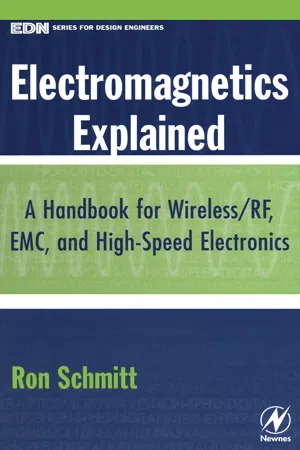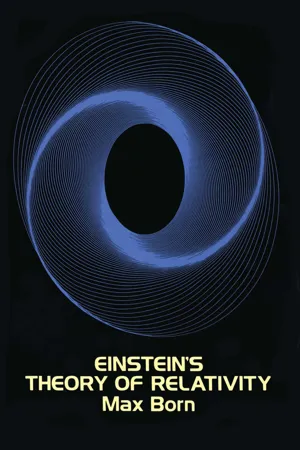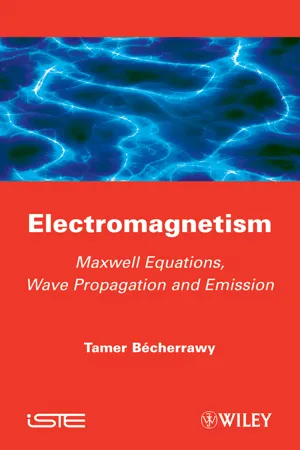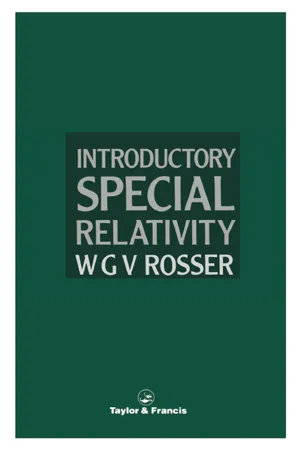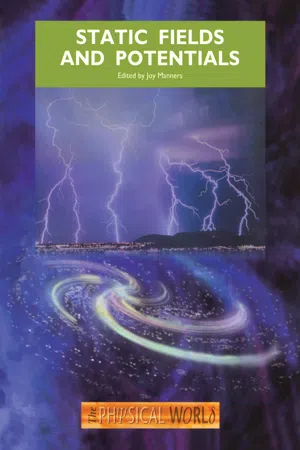Physics
Lenz's Law
Lenz's Law states that the direction of an induced electromotive force (emf) in a circuit is always such that it opposes the change in magnetic flux that produced it. This law is based on the principle of conservation of energy and is used to determine the direction of induced currents in electromagnetic phenomena, such as electromagnetic induction and eddy currents.
Written by Perlego with AI-assistance
Related key terms
Related key terms
1 of 4
Related key terms
1 of 3
10 Key excerpts on "Lenz's Law"
- eBook - ePub
- Adrian Waygood(Author)
- 2018(Publication Date)
- Routledge(Publisher)
The current resulting from the induced potential difference, due to the motion of a conductor through a magnetic field, must act in such a direction that its own magnetic field will then oppose the motion that is causing that induced potential difference.This statement is one interpretation of what is known as Lenz’s Law , and we will meet other interpretations later.You may find it necessary to re-read this statement through a couple of times, as it can be rather confusing the first time around! In the meantime, let’s see if we can make Lenz’s Law more understandable, by considering it step by step.Firstly, let’s see if we can explain it in terms of Fleming’s Right - and Left-Hand Rules .Figure 19.11 shows the lower side of a continuous rectangular loop of wire being pushed downwards through a magnetic field.Figure 19.11If you apply Fleming’s Right-Hand Rule (for ‘generator’ action) to this conductor, you will see that the resulting induced potential difference acts towards you, causing a current to drift in the same direction – as illustrated in Figure 19.12 .If we now apply Fleming’s Left-Hand Rule (for ‘motor’ action) to this current we see that the resulting force (i.e. the ‘reaction’) due to that current will act upwards . That is, it will react against the direction of downward motion (Figure 19.13 ).In case you also found this explanation rather confusing, let’s try yet another approach . .. This time, we’ll ignore Fleming’s Rules, and concentrate on the magnetic flux set up around the conductor due to the current drifting through itIn Figure 19.14 , the conductor is forced downwards through the magnetic field, and a potential difference is induced into the conductor.If the conductor is connected to an external load, then a current will flow in the direction shown (towards you).Figure 19.12Figure 19.13Figure 19.14In Figure 19.15 , we see the magnetic field surrounding the conductor, caused by the current drifting through it. For clarity, we have not - eBook - ePub
Electromagnetics Explained
A Handbook for Wireless/ RF, EMC, and High-Speed Electronics
- Ron Schmitt(Author)
- 2002(Publication Date)
- Newnes(Publisher)
Continuing with the present example, when the power is turned on, a magnetic field starts to develop around the wires. Because the magnetic field is changing from zero to a non-zero value, Lenz’s law states that an electric field is generated that opposes the change. This electric field manifests itself in the circuit as voltage. The opposing voltage persists until the current reaches its final steady-state value. The current, therefore, cannot change instantaneously, but continuously changes from zero to its final value over a period of time. Furthermore, while the current is increasing, a voltage drop exists across the wires. A voltage together with a current implies power loss. Although all real wires have resistive (heating) losses, you can ignore such losses for this example. The power loss encountered here actually corresponds to the power transferred into the magnetic field surrounding wires. Just as it takes energy to increase the speed of a car, it also takes energy to increase the speed of change in a circuit (i.e., the current). You can think of Lenz’s law as a way in which nature “balances its books.” Energy is always conserved, and Lenz’s law tells us how energy conservation is maintained with magnetic fields.FARADAY’S LAW
Lenz’s law provides a qualitative understanding of how a changing magnetic field creates an electric field. Faraday’s law, proposed by 19th-century scientist Michael Faraday, describes this action qualitatively. For a solenoid with N turns and a cross sectional area A, Faraday’s law can be written aswhere dB/dt is the change in magnetic field per unit time and ν is the resulting voltage in the circuit.INDUCTORS
At last it is time to learn about inductors. In contrast to the capacitor, which requires only one field (namely the electric field) to describe its operation, the inductor requires both fields to describe its operation even though it stores only magnetic energy. Here again is an inherent difference between the electric and magnetic fields. An inductor is a circuit element used to store magnetic energy. Typically, an inductor is created from several loops of wire stacked together to form a solenoid. The stacking of several loops serves to concentrate a large magnetic field in a small volume. The magnitude of an inductor is measured by its inductance, which depends on the size and shape of the coil of wires. For a very long solenoid, the inductance is approximately - No longer available |Learn more
- Robert A. Pelcovits, Joshua Farkas(Authors)
- 2023(Publication Date)
- Barrons Educational Services(Publisher)
a: Because the gaussian surface encloses no net charge, it must experience zero electric flux. This requires the radial component of the field to be zero. Therefore, the electric field must be tangent to the direction of integration. Therefore,Figure 15.7 Finally, applying Faraday’s law, form II, yieldsLenz’s Law and Determining the Direction of the EMF
As mentioned in the introduction, it is generally easiest to use Faraday’s law in the form we stated (without reference to signs) to find the magnitude of the induced EMF and to use Lenz’s law to find the direction of the induced EMF.The best way to explain this is by presenting an example.Lenz’s law: The induced current produces a magnetic field, which in turn produces a flux that opposes the change in flux in the loop caused by the changing external magnetic field.Example 15.5 Applying Lenz’s LawA circular loop of wire is located in a region of space where an external magnetic field points out of the page. If the external magnetic field is decreasing, what is the direction of the induced current?SolutionThe external magnetic field is decreasing, which causes a decreasing flux through the loop. According to Lenz’s law, the induced current should flow in the direction that opposes this decrease in flux. Therefore, inside the loop, the induced magnetic field should point out of the page (to bolster the decreasing external magnetic field). Using the right-hand rule, you can see that a counterclockwise current causes a magnetic field that comes out of the page inside the loop of wire. Therefore, the induced current must flow in a counterclockwise direction. - eBook - ePub
- Jo Verhaevert(Author)
- 2024(Publication Date)
- Routledge(Publisher)
The experimental procedure described above is purely qualitative. However, if it was refined and performed under controlled conditions, it would yield the following results: the magnitude of the induced emf is directly proportional to the value of magnetic flux, the rate at which this flux links with the coil and the number of turns on the coil. Expressed as an equation we have:e =− N d Φd t(5.1) Notes:- The symbol for the induced emf is shown as a lower-case letter e and is expressed in volt. This is because it is only present for the short interval of time during which there is relative movement taking place, and so has only a momentary value.
- The term dΦ/dt is simply a mathematical means of stating ‘the rate of change of flux with time’. The combination NΦ/dt is often referred to as the ‘rate of change of flux linkages’.
- Equation (5.1) forms the basis for the definition of the unit of magnetic flux, the weber, thus: the weber is that magnetic flux which, linking a circuit of one turn, induces in it an emf of 1 volt when the flux is reduced to zero at a uniform rate in 1 second.
- The minus sign is a reminder that Lenz’s law applies. This law states that the polarity of an induced emf is always such that it opposes the change which produced it. This is similar to the statement in mechanics, and that for every force there is an opposite reaction.
Heinrich Lenz (1804–1865) was a Baltic-German physicist and studied electromagnetism, by repeating and carefully expanding experiments by Michael Faraday. In addition to the law named after him, Lenz also independently discovered Joule’s law.5.2 Fleming’s Right-Hand Rule
This is a convenient means of determining the polarity of an induced emf in a conductor. Also, provided that the conductor forms part of a complete circuit, it will indicate the direction of the resulting current flow. - eBook - ePub
- Max Born(Author)
- 2012(Publication Date)
- Dover Publications(Publisher)
Here it is due to a change of the area f produced by the movement of the wire. If its length is l and its velocity perpendicular to its extension is v, then it sweeps out the area lv each second, and this is the change of f. The change of the number of lines of force per second is therefore vl μ H. According to Faraday's induction law an electric current J is induced in the wire. Instead of speaking of the current J it is better to express the effect in terms of the potential difference V produced between the ends of the wire. The experiment gives V proportional to the quantity just discussed, vl μ H. Concerning the factor of proportionality, a remarkable law of symmetry has been revealed. If one measures all quantities in units here used, this factor turns out to be, so that one has the equation. Seen from the wire this corresponds to an electric field. If the same piece of wire were to move without being part of a closed circuit, there would appear charges at the end of the wire corresponding to this field as long as the movement went on. Fig. 101 Motion of a wire of length 1,s which is part of a closed circuit, in a magnetic field between the ends of a large horseshoe magnet. This law is the basis of all machines and apparatus of physics and electrotechnical science in which energy of motion is transformed by induction into electromagnetic energy; these include, for example, the telephone, and dynamo machines of every kind. Hence the law may be regarded as having been confirmed by countless experiments. Fig. 102 A charged condenser is filled with a disk-shaped insulator. In the insulator the displacement has induced charges on the surface of the disk. One part of the displacement (dipoles ±) is caused by the ether, the other part (dipoles ±) by the insulator. If the insulator is moved, only the insulator dipoles are moved with it. 2a - eBook - ePub
Electromagnetism
Maxwell Equations, Wave Propagation and Emission
- Tamer Becherrawy(Author)
- 2013(Publication Date)
- Wiley-ISTE(Publisher)
R dt . We note that our analysis neglects the magnetic field produced by the induced current (i.e. self-induction).Figure 8.1.Lorentz induction: a) in a moving rod, and b) in a circuit in motion, c) and d) induction without variation of fluxThe induced emf [8.10] agrees with Faraday's law [8.1 ] with the variation of the flux due to the variation of the circuit area. Indeed, let us orient the circuit formed by the rod and rails in the direction OMNP (according to the right-hand rule about Oz ). The unit normal vector n is then oriented in the direction of Oz and the magnetic flux through the circuit in the direction of n is positive and equal to BDx , where x is the coordinate of M . Its rate of variation is Thus, we have an induced emf and an induced current –BDv o /R. The negative sign means that it is effectively in the opposite direction (i.e. in the direction OPNM ). Another way to apply Lenz's Law is to say that if v o is positive, the flux in the direction of n increases. In order to oppose this increase, the induced current must produce a flux in the opposite direction. Thus, the current must be in the direction OPNM .This result holds for any open or closed circuit moving or deformed in a field B (Figure 8.1b ). Indeed, let us assume that has an infinitesimal translational motion v odt from the position 1 to the position 2 generating a cylindrical surface. We orient and we consider an elements d r , over which B is approximately uniform. The induced emf over d r is We may write where dS is the lateral surface that is swept by the element d r in the interval of time dt and n is the normal unit vector outgoing from the lateral surface. We deduce that is the lateral magnetic flux that is cut by d r . Thus the induced emf in is[8.13]is the total flux outgoing from the lateral surface. The conservation of magnetic flux implies that Thus, the induced emf in the circuit may be written as in accordance with Faraday's law [8.1 - eBook - ePub
- W G V Rosser(Author)
- 2017(Publication Date)
- CRC Press(Publisher)
8 Electromagnetism and Special Relativity 8.1 INTRODUCTIONWhen students are taught electromagnetism for the first time, it is inevitable that the individual laws such as Coulomb’s law, Ampère’s circuital law and Faraday’s law of electromagnetic induction are introduced separately. As a result, many students tend to think of these laws as describing completely independent phenomena, and very few are aware of even the relative orders of magnitude of the electric and magnetic forces between moving charges, let alone the intimate connection between the electric and magnetic forces between moving charges.In Section 8.2 the ratio of the electric to the magnetic forces in a simple case will be calculated using formulae familiar to most first-year undergraduates. The example will then be discussed in Section 8.3 , taking Coulomb’s law and the transformations of the theory of special relativity as axiomatic. This will illustrate the unity of electromagnetism in a vivid way, and show that the theory of classical electromagnetism is consistent with the theory of special relativity. The field transformations for E and B will be derived in Section 8.4 from the assumption that the expression for the Lorentz force, given by equation (2.24) , is valid in all inertial reference frames. After deriving the expressions for the electric and magnetic fields due to a charge moving with uniform velocity in Section 8.5 , we shall go on in Section 8.6 to show that Maxwell’s equations are Lorentz-covariant; that is, they obey the principle of relativity when the coordinates and time are transformed using the Lorentz transformations.8.2 FORCES BETWEEN TWO PARALLEL CONVECTION CURRENTSConsider two infinitely long, straight, thin, uniformly charged, non-conducting wires a distance r apart in vacuum lying in the (x,y) plane of an inertial reference frame ∑. Let both wires move in the positive x direction with uniform velocity ν relative to ∑, as shown in Fig. 8.1 . Let the electric charge per unit length on the wires be λ, measured relative to ∑. Since the wires are moving relative to ∑, the charge distributions give rise to convection currents relative to ∑. The charge passing any point in unit time is λυ, so that the magnitude of the convection currents is λυ - Kam Tim Chau(Author)
- 2019(Publication Date)
- CRC Press(Publisher)
We can see from the last section that there can be a net positive charge or negative charges in a closed space such that the divergence of the electric field is proportional to it. The mathematical structure of (10.3) is identical to (10.2). The zero on the right-hand side actually implies a very important concept in magnetism. That is, magnetic monopoles do not exist. If they did exist, there would be a nonhomogeneous term on the right-hand side of (10.3). That is, we can only find a dipole in magnetism not a monopole that corresponds to charges in the electric field. In fact, this observation has been made by Matthew Hale, John Michell, and C.A. Coulomb. Poisson in 1824 developed a mathematical theory for magnetism and introduced the concept of the magnetic dipole moment, suggesting formally that a monopole does not exist. It was Gauss in 1832 who conducted careful experiments to verify the inverse square law for magnetic forces. Recognizing the formalism for deriving (10.2) also applicable to magnetism and the fact that monopoles do not exist, Gauss formulated the law of magnetism. We will show that for the case of no electric charge, there is a very nice dual symmetry in the Maxwell equations. Assuming the existence of mathematical beauty and simplicity in physical laws, many physicists believe that a monopole must exist in nature such that the Maxwell equations will possess true symmetry. So far, nobody has discovered the existence of a monopole. This idea of non-existence of the monopole can date back to 1269 by Petrus Peregrinus, and adopted by Gilbert and Faraday. We will discuss this more in a later section.
The Maxwell-Faraday law is a generalization of Faraday’s law of electromagnetic induction:10.2.3 Maxwell-Faraday Law(10.4)∇ × 2 E = -∂ 2 B∂ tPhysically, it states that a time-varying magnetic field will always accompany a spatially varying non-conservative electric field. This is an important piece in the formulation of the Maxwell equations. This law was inspired by Faraday’s experiment on magnetic coils in 1831. In fact, electromagnetic induction had been discovered by Joseph Henry in 1830, which was, however, unknown to Faraday. Faraday showed that the energy of a magnet is in the field around it and not in the magnet itself, and that magnetism can be converted to electricity. Without this discovery, he would not invent the dynamo and electric motor. Without such discoveries our daily lives would no longer be the same. Faraday was largely self-taught, and his life changed when he worked for Humphry Davy at the Royal Institution in 1813 as a laboratory assistant. Faraday also established the link between electricity and chemical affinity, or electrolysis. He also considered light as a form of the electromagnetic waves, which leads to the later development of Maxwell’s theory.- eBook - ePub
- Joy Manners(Author)
- 2020(Publication Date)
- CRC Press(Publisher)
Chapter 4 Magnetic fields and the Lorentz force law DOI: 10.4324/9780429187797-51 The magic of magnetism
Even experienced physicists can still be amazed by the phenomenon of magnetism. Holding two bar magnets and feeling their repulsion or attraction is a reminder of what physics is for. It allows us to describe succinctly what seems at first indescribable, and it allows us to connect what appear to be unconnected phenomena. In particular, in this chapter, we will make the connection between magnetism and electric currents. This link provides the basis of the subject known as electromagnetism.Figure 4.1 demonstrates a purely magnetic effect. It shows several paper clips adhering to a bar magnet. It is a simple demonstration, and, as such, might be treated with a certain condescension. However, there are many reasons why this would be an inappropriate reaction, and several lessons to be learned.- The first is that it is hard to devise any explanation of this phenomenon that does not involve the concept of afield. The influence of the magnet extends into space away from itself and does not involve the passage of any material particles from the magnet to the paper clips.
- The second is that although the field is not a material object in itself, its sources are material and it can only be detected by its effect on matter. Thus, our determination of the properties of a field is, in a sense, always second-hand.
- The third lesson to draw from this demonstration is one of awe. Einstein was in his late sixties when he wrote:
I experienced a miracle … as a child of four or five when my father showed me a compass … [I realized] there had to be something behind objects that lay deeply hidden.’
The topics covered in this chapter range from the forces between current-carrying wires through to the discovery of the radiation belts surrounding the Earth. However, throughout our exploration of these subjects, one concept will figure prominently — the idea of a magnetic field. - eBook - ePub
Fields of Force
The Development of a World View from Faraday to Einstein.
- William Berkson(Author)
- 2014(Publication Date)
- Routledge(Publisher)
12 I should note that Maxwell omitted the electromotive force due to the motion of a magnetically polarized medium. (This omission was first pointed out, I believe, by Helmholtz.)The unified character of electromotive force is characteristic of Maxwell’s theory in ‘On Physical Lines of Force’. In later versions of his theory, the force due to change in the magnetic field is regarded as part of the electrical field, but the force resulting from motion of a conductor is of quite a different character, and not considered part of the electrical field. This division becomes particularly clear in Lorentz’s version of Maxwell’s theory. Maxwell’s mechanical model was the last theory of electricity and magnetism with the unified character that Faraday had dreamed of.Having developed a theory of the relation between currents and magnetism, Maxwell added the final assumption necessary for his mechanism: the elasticity of the electrical balls. He used the property of elasticity of the particles for three purposes: first, to modify the theory of electromagnetic induction; second, to show that static charge could be accounted for by the model; and, third, to show that changes in the electromagnetic field are propagated at the velocity of light. To begin the theory, Maxwell supposed that the amount of displacement of the matter in the balls is directly proportional to the (electromotive) force on the ball (D=(l/4πc 2 )E).13 The constant ‘c ’ characterizes the elasticity of the balls and the specific inductive capacity of the medium is1/4πc 2 .Maxwell first pointed out that the earlier theory of the relation between current and magnetism had to be changed.14 Formerly he had assumed two causes for a difference of velocity between two neighbouring vortices: either there was a current flowing or there was pressure of a moving conductor. Now it became necessary to include the possibility of a change in displacement of the matter of the balls. Consider an electrical ball in a dielectric and two neighbouring vortices. Because of electromotive forces, the ball may be extremely distorted. The material of the ball can be displaced in one direction, say perpendicular to the line connecting the centres of the vortices. This distortion is analogous to electrical polarization. If the ball recovers its spherical shape, then the material is transferred back to its original position. While the transfer is taking place, material on opposite surfaces of the ball will be moving in opposite directions. Thus the neighbouring vortices will be set in motion in opposite directions, exactly as if the ball were moving and a conduction were present. In other words, a change in displacement creates a magnetic field exactly as does a conduction current
Index pages curate the most relevant extracts from our library of academic textbooks. They’ve been created using an in-house natural language model (NLM), each adding context and meaning to key research topics.
Explore more topic indexes
Explore more topic indexes
1 of 6
Explore more topic indexes
1 of 4

